air condition TOYOTA C_HR HYBRID 2016 Owners Manual
[x] Cancel search | Manufacturer: TOYOTA, Model Year: 2016, Model line: C_HR HYBRID, Model: TOYOTA C_HR HYBRID 2016Pages: 712, PDF Size: 49.31 MB
Page 5 of 712
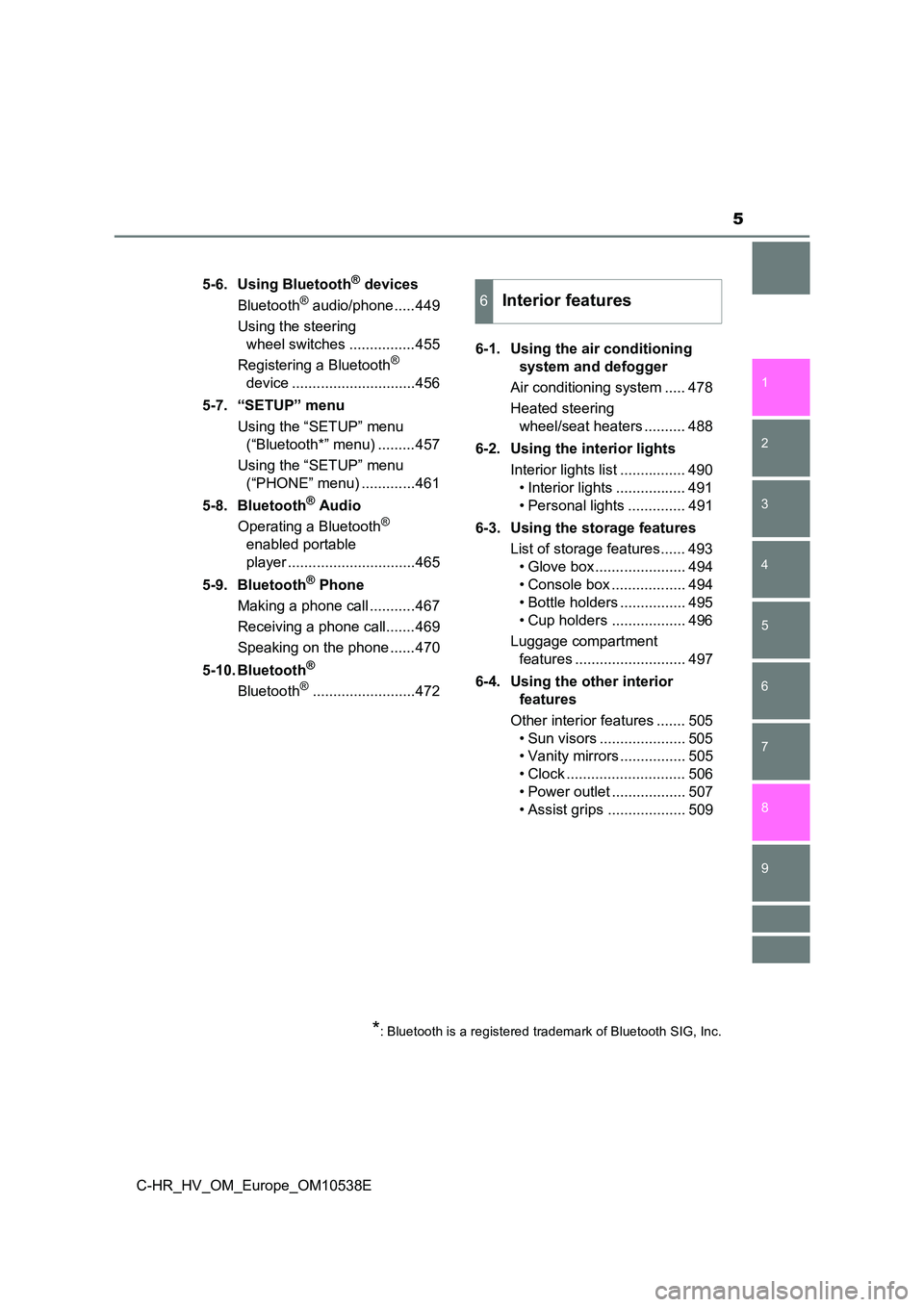
5
1
6
5
4
3
2
C-HR_HV_OM_Europe_OM10538E
9
8
7
5-6. Using Bluetooth® devices
Bluetooth® audio/phone .....449
Using the steering
wheel switches ................455
Registering a Bluetooth®
device ..............................456
5-7. “SETUP” menu
Using the “SETUP” menu
(“Bluetooth*” menu) .........457
Using the “SETUP” menu
(“PHONE” menu) .............461
5-8. Bluetooth® Audio
Operating a Bluetooth®
enabled portable
player ...............................465
5-9. Bluetooth® Phone
Making a phone call ...........467
Receiving a phone call.......469
Speaking on the phone ......470
5-10. Bluetooth®
Bluetooth®.........................472
6-1. Using the air conditioning
system and defogger
Air conditioning system ..... 478
Heated steering
wheel/seat heaters .......... 488
6-2. Using the interior lights
Interior lights list ................ 490
• Interior lights ................. 491
• Personal lights .............. 491
6-3. Using the storage features
List of storage features...... 493
• Glove box ...................... 494
• Console box .................. 494
• Bottle holders ................ 495
• Cup holders .................. 496
Luggage compartment
features ........................... 497
6-4. Using the other interior
features
Other interior features ....... 505
• Sun visors ..................... 505
• Vanity mirrors ................ 505
• Clock ............................. 506
• Power outlet .................. 507
• Assist grips ................... 509
*: Bluetooth is a registered trademark of Bluetooth SIG, Inc.
6Interior features
Page 6 of 712
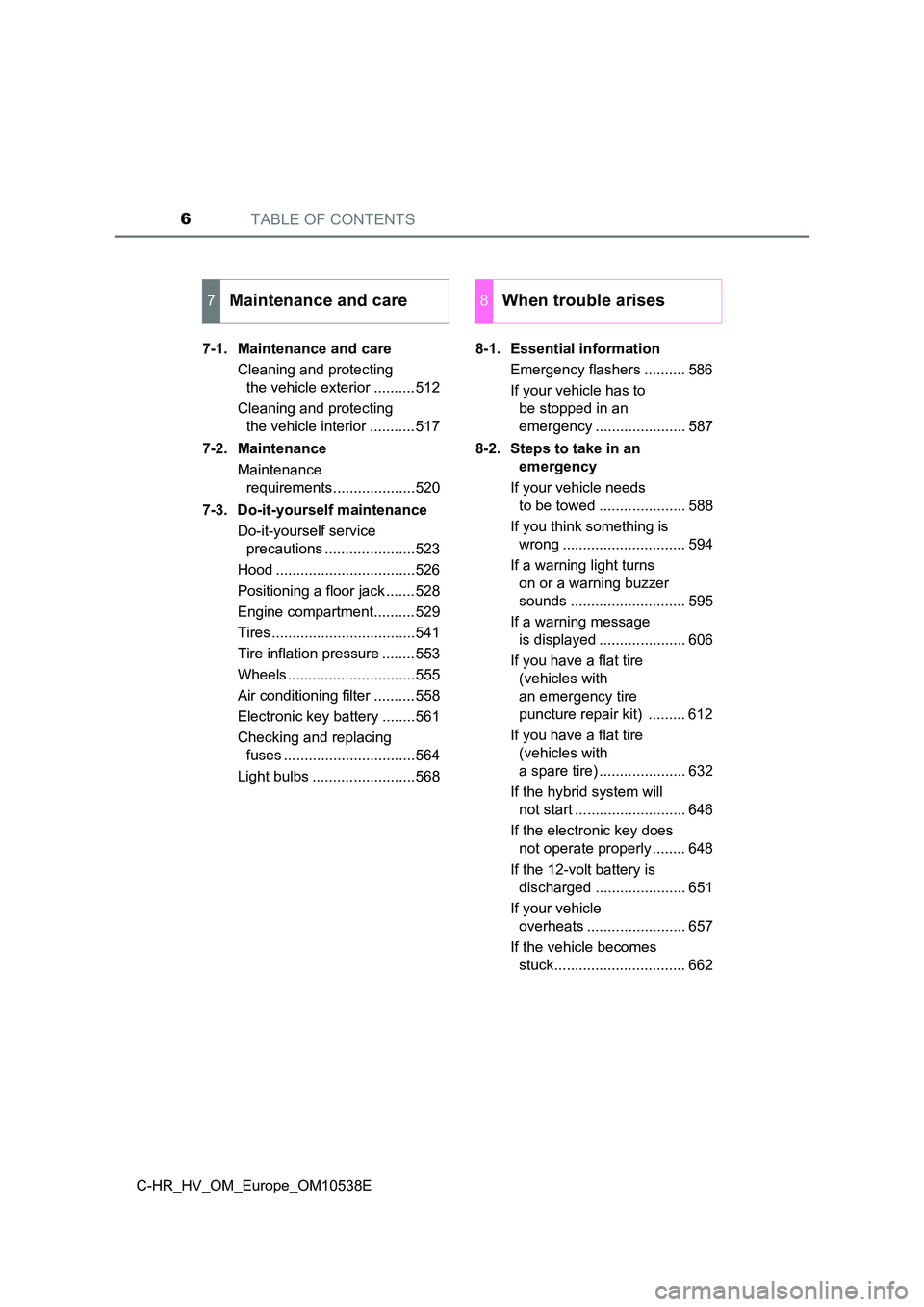
TABLE OF CONTENTS6
C-HR_HV_OM_Europe_OM10538E
7-1. Maintenance and care
Cleaning and protecting
the vehicle exterior ..........512
Cleaning and protecting
the vehicle interior ...........517
7-2. Maintenance
Maintenance
requirements....................520
7-3. Do-it-yourself maintenance
Do-it-yourself service
precautions ......................523
Hood ..................................526
Positioning a floor jack .......528
Engine compartment..........529
Tires ...................................541
Tire inflation pressure ........553
Wheels ...............................555
Air conditioning filter ..........558
Electronic key battery ........561
Checking and replacing
fuses ................................564
Light bulbs .........................568
8-1. Essential information
Emergency flashers .......... 586
If your vehicle has to
be stopped in an
emergency ...................... 587
8-2. Steps to take in an
emergency
If your vehicle needs
to be towed ..................... 588
If you think something is
wrong .............................. 594
If a warning light turns
on or a warning buzzer
sounds ............................ 595
If a warning message
is displayed ..................... 606
If you have a flat tire
(vehicles with
an emergency tire
puncture repair kit) ......... 612
If you have a flat tire
(vehicles with
a spare tire) ..................... 632
If the hybrid system will
not start ........................... 646
If the electronic key does
not operate properly ........ 648
If the 12-volt battery is
discharged ...................... 651
If your vehicle
overheats ........................ 657
If the vehicle becomes
stuck................................ 662
7Maintenance and care8When trouble arises
Page 17 of 712
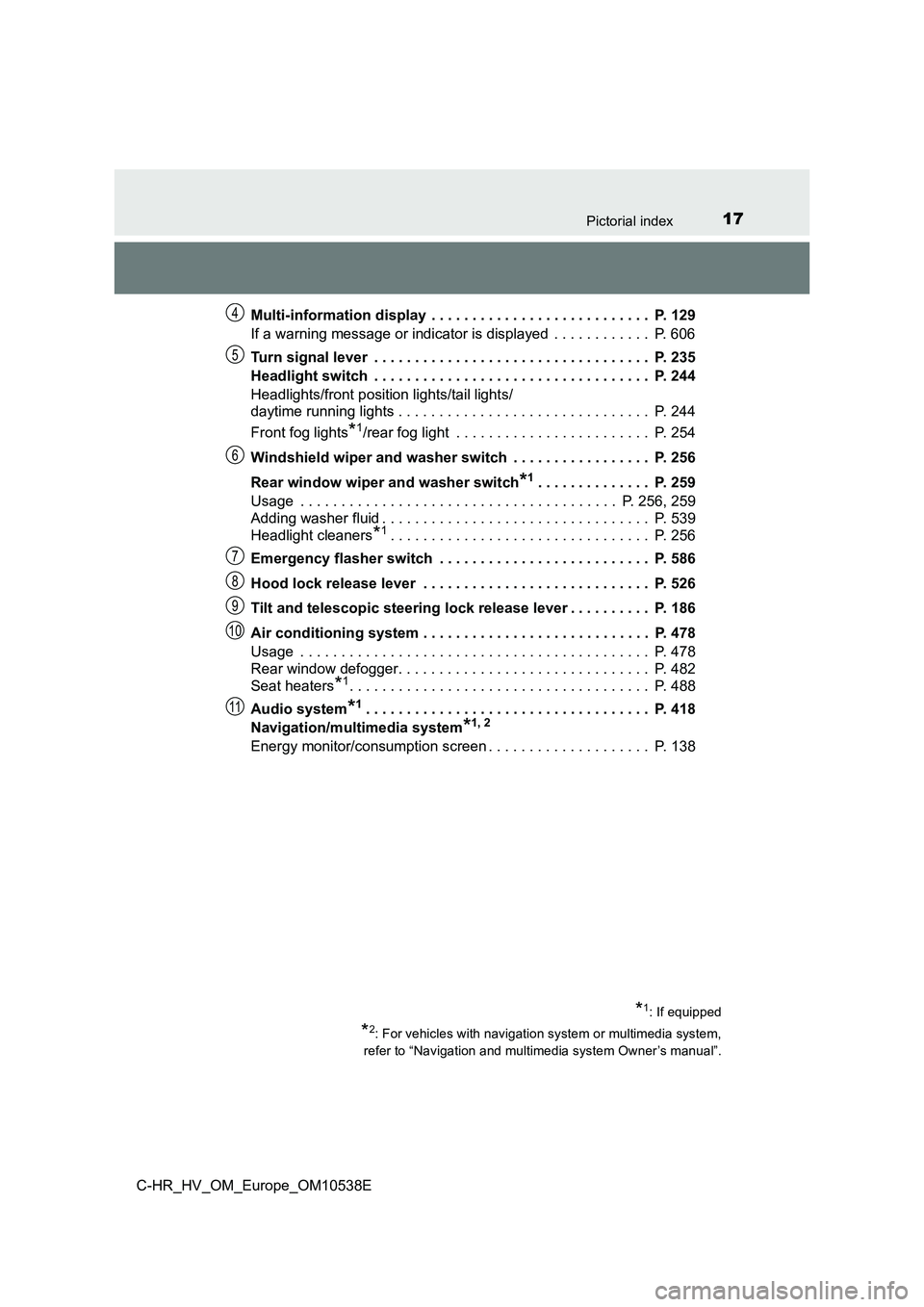
17Pictorial index
C-HR_HV_OM_Europe_OM10538EMulti-information display . . . . . . . . .
. . . . . . . . . . . . . . . . . . P. 129
If a warning message or indicator is displayed . . . . . . . . . . . . P. 606
Turn signal lever . . . . . . . . . . . . . . . . . . . . . . . . . . . . . . . . . . P. 235
Headlight switch . . . . . . . . . . . . . . . . . . . . . . . . . . . . . . . . . . P. 244
Headlights/front position lights/tail lights/
daytime running lights . . . . . . . . . . . . . . . . . . . . . . . . . . . . . . . P. 244
Front fog lights
*1/rear fog light . . . . . . . . . . . . . . . . . . . . . . . . P. 254
Windshield wiper and washer switch . . . . . . . . . . . . . . . . . P. 256
Rear window wiper and washer switch
*1. . . . . . . . . . . . . . P. 259
Usage . . . . . . . . . . . . . . . . . . . . . . . . . . . . . . . . . . . . . . . P. 256, 259
Adding washer fluid . . . . . . . . . . . . . . . . . . . . . . . . . . . . . . . . . P. 539
Headlight cleaners
*1. . . . . . . . . . . . . . . . . . . . . . . . . . . . . . . . P. 256
Emergency flasher switch . . . . . . . . . . . . . . . . . . . . . . . . . . P. 586
Hood lock release lever . . . . . . . . . . . . . . . . . . . . . . . . . . . . P. 526
Tilt and telescopic steering lock release lever . . . . . . . . . . P. 186
Air conditioning system . . . . . . . . . . . . . . . . . . . . . . . . . . . . P. 478
Usage . . . . . . . . . . . . . . . . . . . . . . . . . . . . . . . . . . . . . . . . . . . P. 478
Rear window defogger. . . . . . . . . . . . . . . . . . . . . . . . . . . . . . . P. 482
Seat heaters
*1. . . . . . . . . . . . . . . . . . . . . . . . . . . . . . . . . . . . . P. 488
Audio system
*1. . . . . . . . . . . . . . . . . . . . . . . . . . . . . . . . . . . P. 418
Navigation/multimedia system
*1, 2
Energy monitor/consumption screen . . . . . . . . . . . . . . . . . . . . P. 138
*1: If equipped
*2: For vehicles with navigation system or multimedia system,
refer to “Navigation and multimedia system Owner’s manual”.
4
5
6
7
8
9
10
11
Page 25 of 712
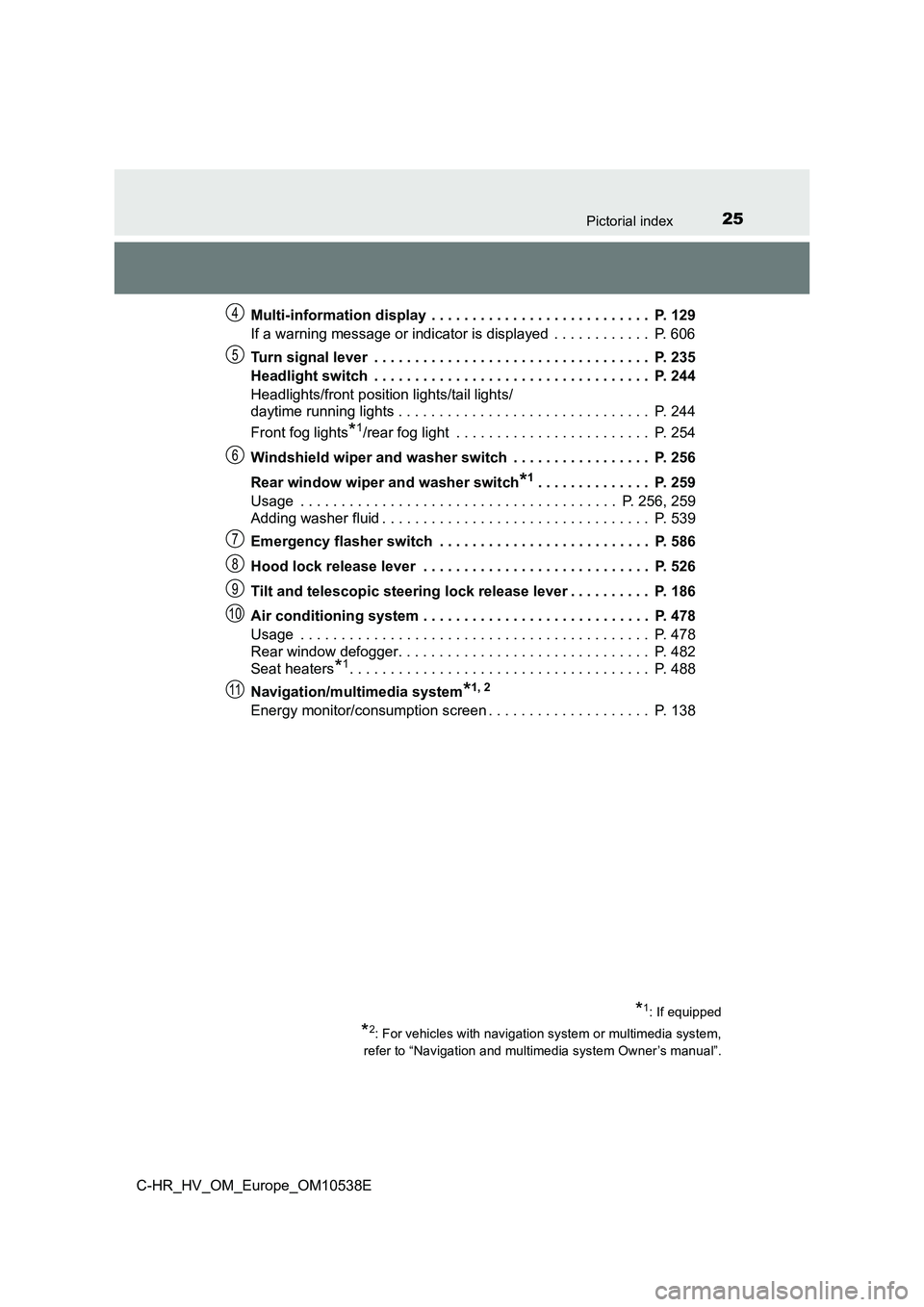
25Pictorial index
C-HR_HV_OM_Europe_OM10538EMulti-information display . . . . . . . . .
. . . . . . . . . . . . . . . . . . P. 129
If a warning message or indicator is displayed . . . . . . . . . . . . P. 606
Turn signal lever . . . . . . . . . . . . . . . . . . . . . . . . . . . . . . . . . . P. 235
Headlight switch . . . . . . . . . . . . . . . . . . . . . . . . . . . . . . . . . . P. 244
Headlights/front position lights/tail lights/
daytime running lights . . . . . . . . . . . . . . . . . . . . . . . . . . . . . . . P. 244
Front fog lights
*1/rear fog light . . . . . . . . . . . . . . . . . . . . . . . . P. 254
Windshield wiper and washer switch . . . . . . . . . . . . . . . . . P. 256
Rear window wiper and washer switch
*1. . . . . . . . . . . . . . P. 259
Usage . . . . . . . . . . . . . . . . . . . . . . . . . . . . . . . . . . . . . . . P. 256, 259
Adding washer fluid . . . . . . . . . . . . . . . . . . . . . . . . . . . . . . . . . P. 539
Emergency flasher switch . . . . . . . . . . . . . . . . . . . . . . . . . . P. 586
Hood lock release lever . . . . . . . . . . . . . . . . . . . . . . . . . . . . P. 526
Tilt and telescopic steering lock release lever . . . . . . . . . . P. 186
Air conditioning system . . . . . . . . . . . . . . . . . . . . . . . . . . . . P. 478
Usage . . . . . . . . . . . . . . . . . . . . . . . . . . . . . . . . . . . . . . . . . . . P. 478
Rear window defogger. . . . . . . . . . . . . . . . . . . . . . . . . . . . . . . P. 482
Seat heaters
*1. . . . . . . . . . . . . . . . . . . . . . . . . . . . . . . . . . . . . P. 488
Navigation/multimedia system
*1, 2
Energy monitor/consumption screen . . . . . . . . . . . . . . . . . . . . P. 138
*1: If equipped
*2: For vehicles with navigation system or multimedia system,
refer to “Navigation and multimedia system Owner’s manual”.
4
5
6
7
8
9
10
11
Page 51 of 712
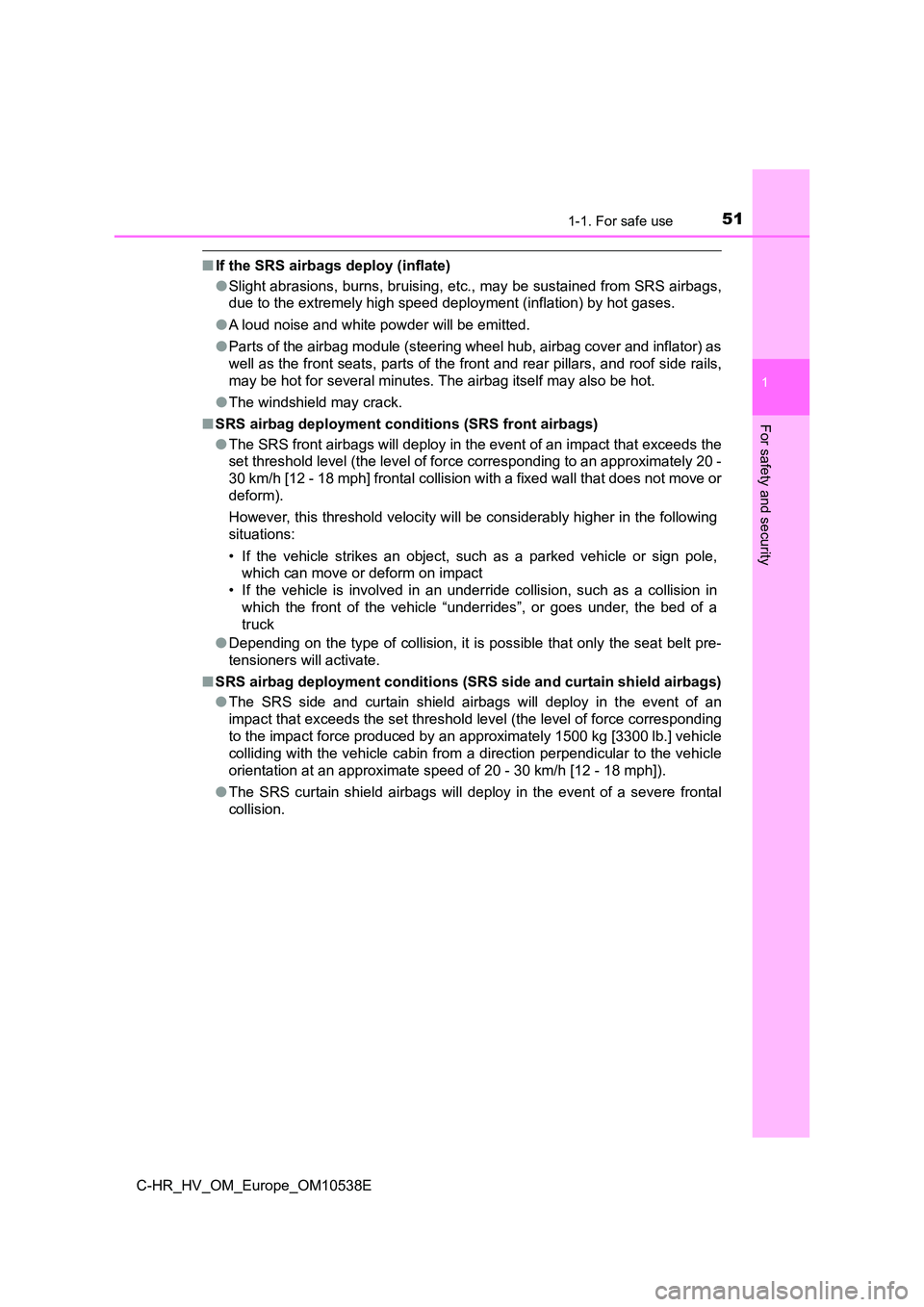
511-1. For safe use
1
For safety and security
C-HR_HV_OM_Europe_OM10538E
■If the SRS airbags deploy (inflate)
● Slight abrasions, burns, bruising, etc., may be sustained from SRS airbags,
due to the extremely high speed deployment (inflation) by hot gases.
● A loud noise and white powder will be emitted.
● Parts of the airbag module (steering wheel hub, airbag cover and inflator) as
well as the front seats, parts of the front and rear pillars, and roof side rails,
may be hot for several minutes. The airbag itself may also be hot.
● The windshield may crack.
■ SRS airbag deployment conditions (SRS front airbags)
● The SRS front airbags will deploy in the event of an impact that exceeds the
set threshold level (the level of force corresponding to an approximately 20 -
30 km/h [12 - 18 mph] frontal collision with a fixed wall that does not move or
deform).
However, this threshold velocity will be considerably higher in the following
situations:
• If the vehicle strikes an object, such as a parked vehicle or sign pole,
which can move or deform on impact
• If the vehicle is involved in an underride collision, such as a collision in
which the front of the vehicle “underrides”, or goes under, the bed of a
truck
● Depending on the type of collision, it is possible that only the seat belt pre-
tensioners will activate.
■ SRS airbag deployment conditions (SRS side and curtain shield airbags)
● The SRS side and curtain shield airbags will deploy in the event of an
impact that exceeds the set threshold level (the level of force corresponding
to the impact force produced by an approximately 1500 kg [3300 lb.] vehicle
colliding with the vehicle cabin from a direction perpendicular to the vehicle
orientation at an approximate speed of 20 - 30 km/h [12 - 18 mph]).
● The SRS curtain shield airbags will deploy in the event of a severe frontal
collision.
Page 52 of 712
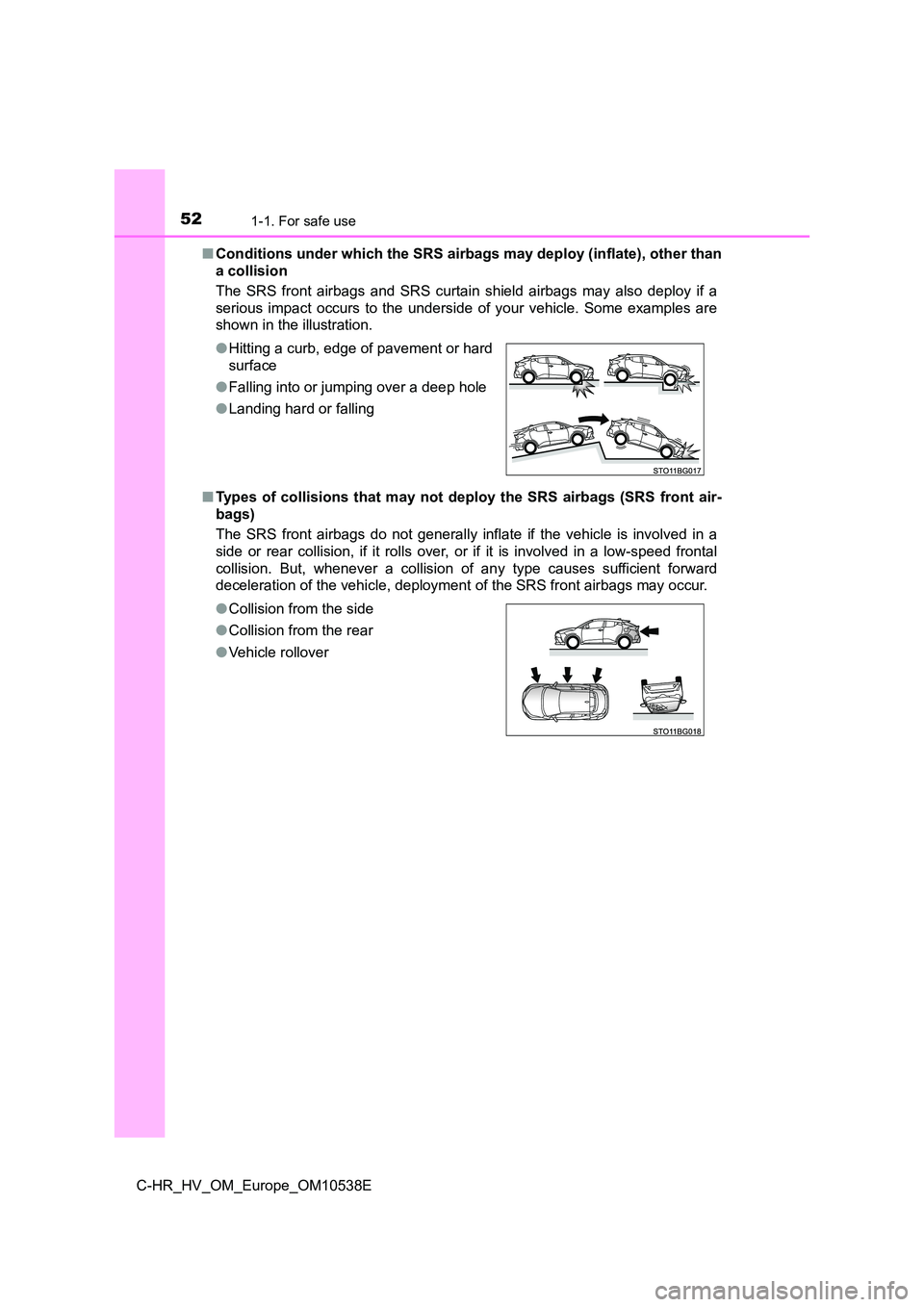
521-1. For safe use
C-HR_HV_OM_Europe_OM10538E
■ Conditions under which the SRS airbags may deploy (inflate), other than
a collision
The SRS front airbags and SRS curtain shield airbags may also deploy if a
serious impact occurs to the underside of your vehicle. Some examples are
shown in the illustration.
■ Types of collisions that may not deploy the SRS airbags (SRS front air-
bags)
The SRS front airbags do not generally infl ate if the vehicle is involved in a
side or rear collision, if it rolls over, or if it is involved in a low-speed frontal
collision. But, whenever a collision of any type causes sufficient forward
deceleration of the vehicle, deployment of the SRS front airbags may occur.
● Hitting a curb, edge of pavement or hard
surface
● Falling into or jumping over a deep hole
● Landing hard or falling
● Collision from the side
● Collision from the rear
● Vehicle rollover
Page 92 of 712
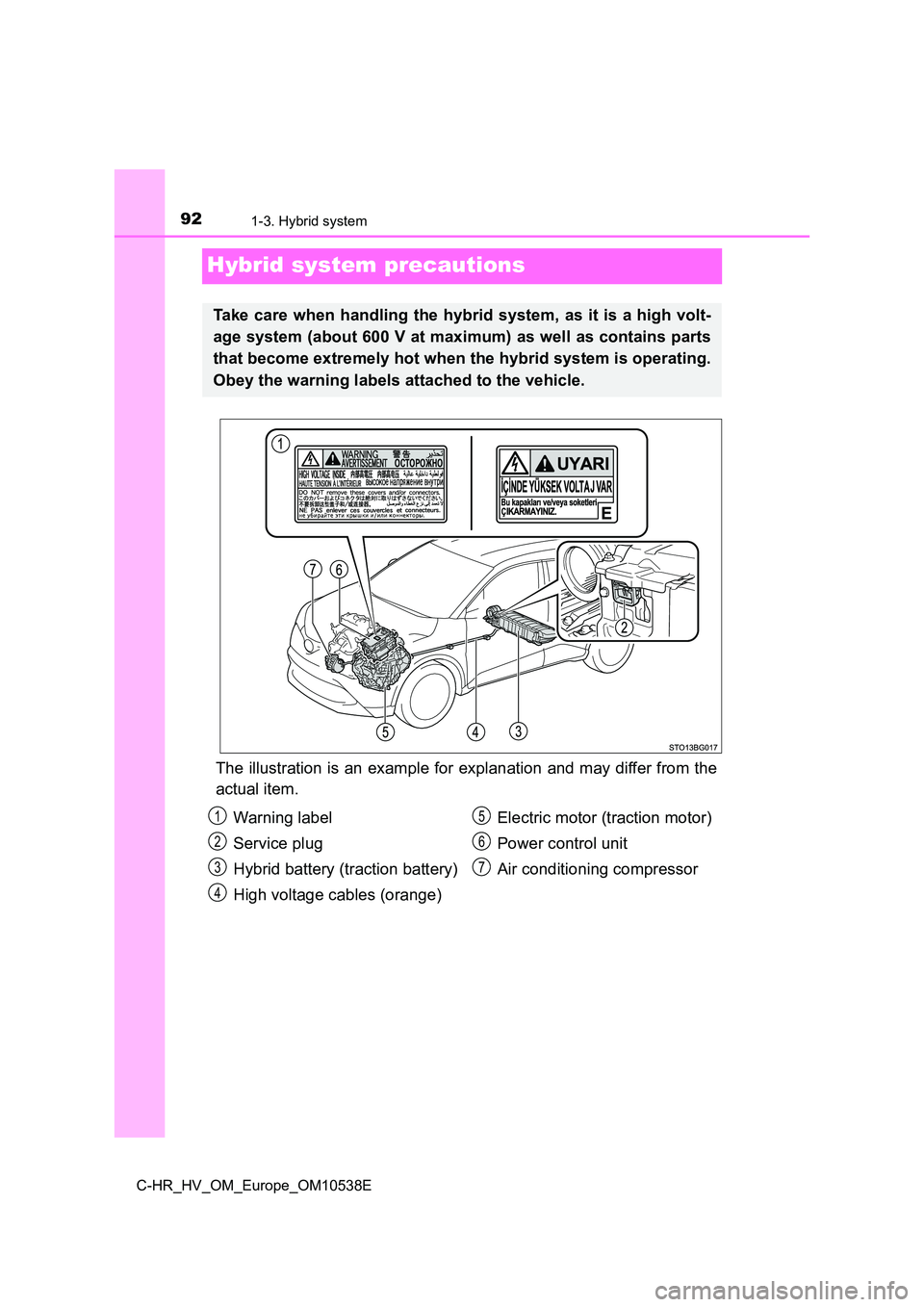
921-3. Hybrid system
C-HR_HV_OM_Europe_OM10538E
Hybrid system precautions
The illustration is an example for explanation and may differ from the
actual item.
Take care when handling the hybrid system, as it is a high volt-
age system (about 600 V at maximum) as well as contains parts
that become extremely hot when the hybrid system is operating.
Obey the warning labels attached to the vehicle.
Warning label
Service plug
Hybrid battery (traction battery)
High voltage cables (orange)
Electric motor (traction motor)
Power control unit
Air conditioning compressor
1
2
3
4
5
6
7
Page 94 of 712
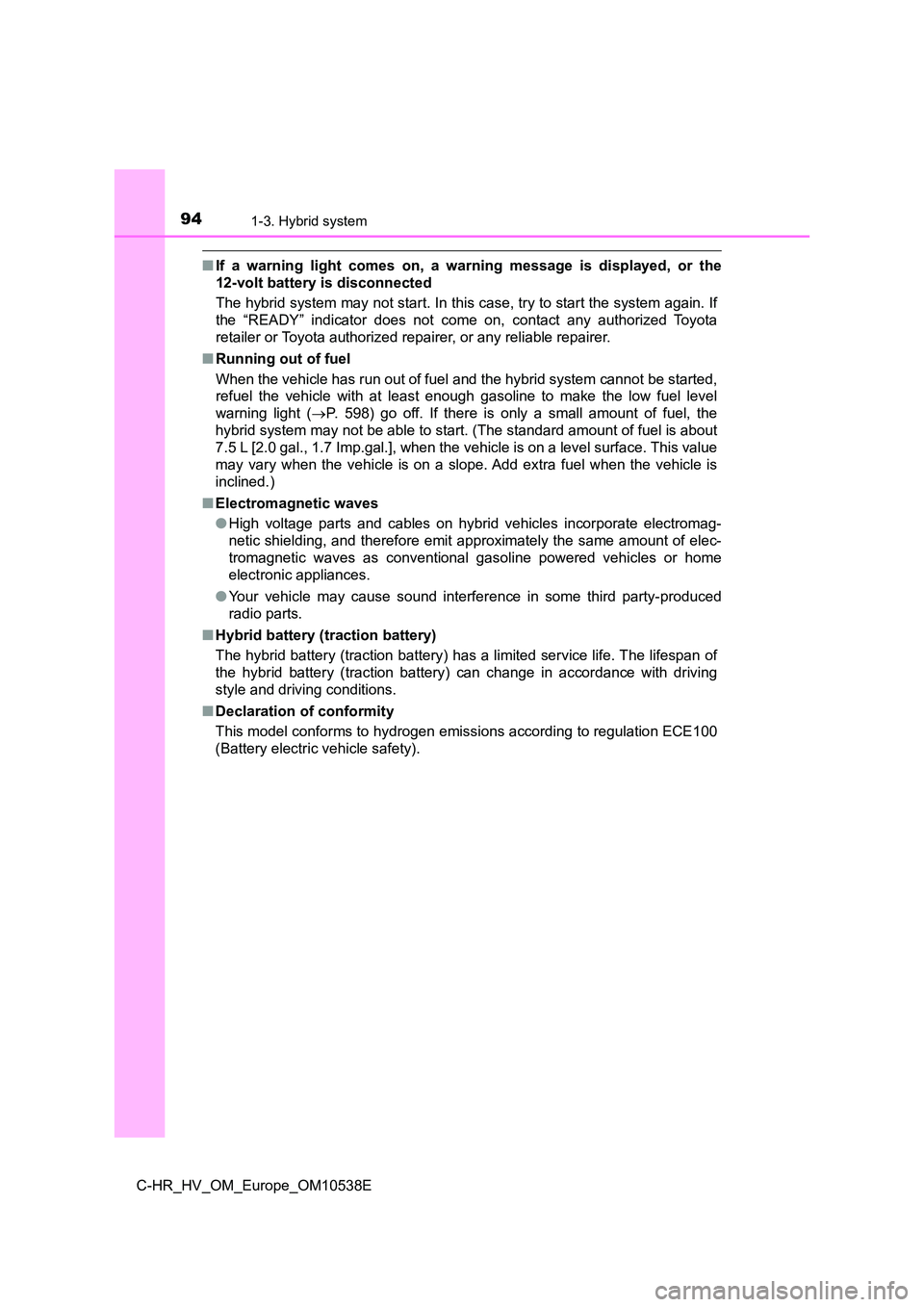
941-3. Hybrid system
C-HR_HV_OM_Europe_OM10538E
■If a warning light comes on, a warning message is displayed, or the
12-volt battery is disconnected
The hybrid system may not start. In this case, try to start the system again. If
the “READY” indicator does not come on, contact any authorized Toyota
retailer or Toyota authorized repairer, or any reliable repairer.
■ Running out of fuel
When the vehicle has run out of fuel and the hybrid system cannot be started,
refuel the vehicle with at least enough gasoline to make the low fuel level
warning light ( P. 598) go off. If there is only a small amount of fuel, the
hybrid system may not be able to start. (The standard amount of fuel is about
7.5 L [2.0 gal., 1.7 Imp.gal.], when the vehicle is on a level surface. This value
may vary when the vehicle is on a slope. Add extra fuel when the vehicle is
inclined.)
■ Electromagnetic waves
● High voltage parts and cables on hybrid vehicles incorporate electromag-
netic shielding, and therefore emit approximately the same amount of elec-
tromagnetic waves as conventional gasoline powered vehicles or home
electronic appliances.
● Your vehicle may cause sound interference in some third party-produced
radio parts.
■ Hybrid battery (traction battery)
The hybrid battery (traction battery) has a limited service life. The lifespan of
the hybrid battery (traction battery) can change in accordance with driving
style and driving conditions.
■ Declaration of conformity
This model conforms to hydrogen emissions according to regulation ECE100
(Battery electric vehicle safety).
Page 128 of 712

1282. Instrument cluster
C-HR_HV_OM_Europe_OM10538E
■ Engine speed
On hybrid vehicles, engine speed is precisely controlled in order to help
improve fuel efficiency and reduce exhaust emissions, etc.
There are times when the engine speed that is displayed may differ even
when vehicle operation and driving conditions are the same.
■ Outside temperature display
● In the following situations, the correct outside temperature may not be dis-
played, or the display may take longer than normal to change.
• When stopped, or driving at low speeds (less than 25 km/h [16 mph])
• When the outside temperature has changed suddenly (at the entrance/
exit of a garage, tunnel, etc.)
● When “--” is displayed, the system may be malfunctioning.
Take your vehicle to any authorized Toyota retailer or Toyota authorized
repairer, or any reliable repairer.
NOTICE
■ To prevent damage to the engine and its components
The engine may be overheating if the engine coolant temperature gauge is
in the red zone (“H”). In this case, immediately stop the vehicle in a safe
place, and check the engine after it has cooled completely. ( P. 657)
Page 145 of 712
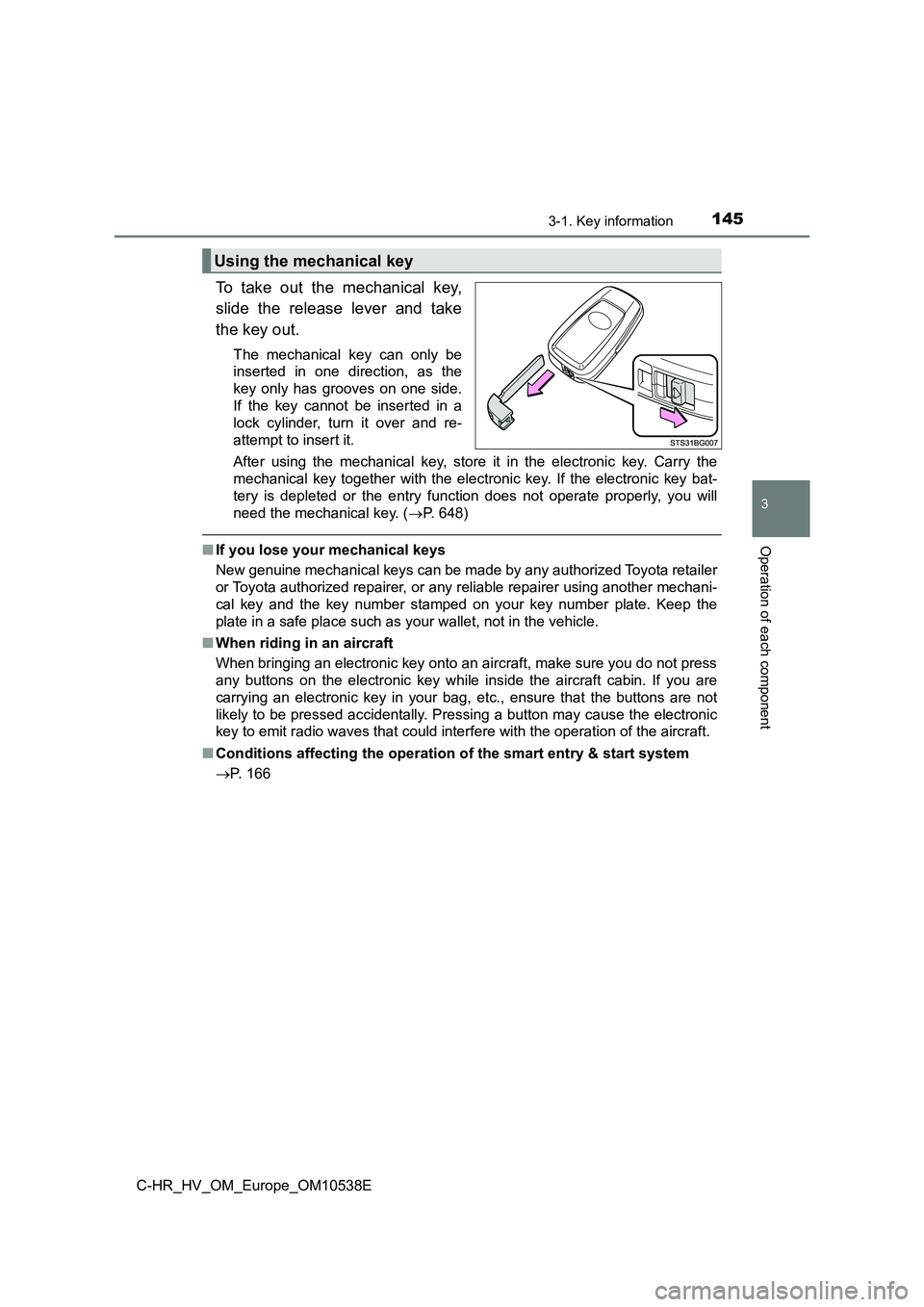
1453-1. Key information
3
Operation of each component
C-HR_HV_OM_Europe_OM10538E
To take out the mechanical key,
slide the release lever and take
the key out.
The mechanical key can only be
inserted in one direction, as the
key only has grooves on one side.
If the key cannot be inserted in a
lock cylinder, turn it over and re-
attempt to insert it.
After using the mechanical key, store it in the electronic key. Carry the
mechanical key together with the electronic key. If the electronic key bat-
tery is depleted or the entry func tion does not operate properly, you will
need the mechanical key. ( P. 648)
■If you lose your mechanical keys
New genuine mechanical keys can be made by any authorized Toyota retailer
or Toyota authorized repairer, or any reliable repairer using another mechani-
cal key and the key number stamped on your key number plate. Keep the
plate in a safe place such as your wallet, not in the vehicle.
■ When riding in an aircraft
When bringing an electronic key onto an aircraft, make sure you do not press
any buttons on the electronic key while inside the aircraft cabin. If you are
carrying an electronic key in your bag, etc., ensure that the buttons are not
likely to be pressed accidentally. Pressing a button may cause the electronic
key to emit radio waves that could interfere with the operation of the aircraft.
■ Conditions affecting the operation of the smart entry & start system
P. 166
Using the mechanical key